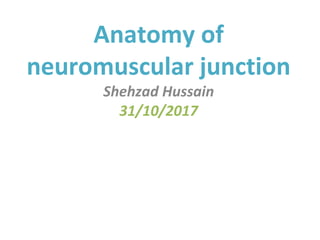
Anatomy of neuromuscular junction
- 1. Anatomy of neuromuscular junction Shehzad Hussain 31/10/2017
- 2. Index: 1. Introduction 2. Introduction as RNS 3. NMJ physiology 4. Number of quanta
- 3. Introduction: • The use of repetitive nerve stimulation (RNS) dates back to the late 1800s, when Jolly made visual observations of muscle movement that occurred after nerve stimulation. Although his initial studies were done with submaximal stimuli and mechanical rather than electrical measurements were made, Jolly noted a decrementing response following RNS in patients with myasthenia gravis and correctly concluded that the disorder was peripheral.
- 4. INTRODUCTION TO RNS Subsequently, RNS has been refined and validated as one of the most useful electrodiagnostic (EDX) tests in the evaluation of patients with suspected neuromuscular junction (NMJ) disorders. RNS should be performed whenever there is a possible diagnosis of myasthenia gravis, Lambert-Eaton myasthenic syndrome, or botulism.
- 5. Cont... CLINICAL PRESENTATION: •It also should be considered in any patient who presents with fatigability, proximal weakness, dysphagia, dysarthria, or ocular abnormalities, which are clinical symptoms and signs suggestive of a possible NMJ disorder
- 6. NORMAL NEUROMUSCULAR JUNCTION PHYSIOLOGY • The NMJ essentially forms an electrical-chemical- electrical link between nerve and muscle (Figure). The chemical neurotransmitter at the NMJ is acetylcholine (ACH). ACH molecules are packaged as vesicles in the presynaptic terminal in discrete units known as quanta; each quantum contains approximately 10,000 molecules of ACH. The quanta are located in three separate stores. The primary, or immediately available, store consists of approximately 1,000 quanta located just beneath the presynaptic nerve terminal membrane.
- 7. Cont… This store is immediately available for release. The secondary, or mobilization, store consists of approximately 10,000 quanta that can resupply the primary store after a few seconds. Finally, a tertiary, or reserve, store of more than 100,000 quanta exists far from the NMJ in the axon and cell body.
- 8. Cont… • When a nerve action potential invades and depolarizes the presynaptic junction, voltage-gated calcium channels are activated, allowing an influx of calcium. The infusion of calcium starts a complicated interaction of many proteins that ends in the release of ACH from the presynaptic terminal. The greater the calcium concentration inside the presynaptic terminal, the more quanta are released. ACH then diffuses across the synaptic cleft and binds to ACH receptors (ACHRs) on the postsynaptic muscle membrane. The postsynaptic membrane is composed of numerous junctional folds, effectively increasing the surface area of the membrane, with ACHRs clustered on the crests of the folds.
- 12. Cont… The binding of ACH to ACHRs opens sodium channels, resulting in a local depolarization, the endplate potential (EPP). The size of the EPP is proportional to the amount of ACH that binds to the ACHRs. In a process similar to the generation of a nerve action potential, if the EPP depolarizes the muscle membrane above threshold, an all-or-none muscle fiber action potential is generated and propagated through the muscle fiber. Under normal circumstances, the EPP always rises above threshold, resulting in a muscle fiber action potential.
- 13. How an action potential is generated? NMJ.WMV
- 14. • The amplitude of the EPP above the threshold value needed to generate a muscle fiber action potential is called the safety factor. In the synaptic cleft, ACH is broken down by the enzyme acetylcholinesterase, and the choline subsequently is taken up into the presynaptic terminal to be repackaged into ACH. During slow RNS (2-3 Hz) in normal subjects, ACH quanta are progressively depleted from the primary store, and fewer quanta are released with each successive stimulation.
- 15. Cont… The corresponding EPP falls in amplitude, but because of the normal safety factor, it remains above threshold to ensure generation of a muscle fiber action potential with each stimulation. After the first few seconds, the secondary (mobilization) store begins to replace the depleted quanta with a subsequent rise in the EPP. The physiology of rapid RNS (10-50 Hz) in normal subjects is more complex. Depletion of quanta from the presynaptic terminal is counterbalanced not only by the mobilization of quanta from the secondary store but also by the accumulation of calcium.
- 16. Cont.. Normally, it takes about 100 ms for calcium to be actively pumped out of the presynaptic terminal. If RNS is rapid enough so that new calcium influx occurs before the previously infused calcium has been fully pumped out, calcium accumulates in the presynaptic terminal, causing an increased release of quanta. Normally, this accumulation of calcium predominates over depletion, leading to an increased number of quanta being released and a correspondingly higher EPP. However, the result is the same as with any other EPP above threshold: an all- or-none muscle fiber action potential is generated.
- 17. Cont… • Thus, the effects of slow and rapid RNS are very different at the molecular level, yet in normal subjects the result is the same: the consistent generation of a muscle fiber action potential. In pathologic conditions where the safety factor is reduced (i.e., baseline EPP is reduced but still above threshold), slow RNS will cause depletion of quanta and may drop the EPP below threshold, resulting in the absence of a muscle fiber action potential.
- 18. Cont… In pathologic conditions where baseline EPP is below threshold and a muscle fiber action potential is not generated, rapid RNS may increase the number of quanta released, resulting in a larger EPP, so that threshold is reached. A muscle fiber action potential then is generated where one had not been present previously. These concepts form the basis of the decrements with slow RNS and increments with rapid RNS that are seen in NMJ disorders.
- 19. The end